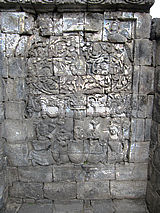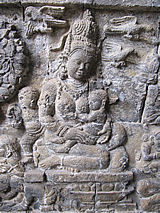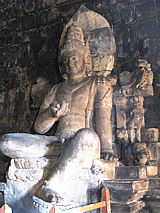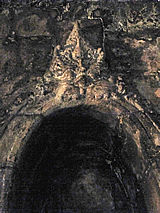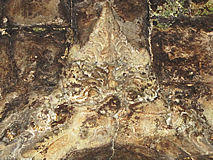Official website
of
HAN MARIE STIEKEMA
VIVA! JAVA
* Javanese mysticism
(Kebatinan) & Traditional Javanese religious tolerance: a model to the world?
*The Yogya Kraton Myth
*Taman Sari
*The Gunungan
*Tutup Ngisor
*What we can do for Java....
*Java: Land of Kala, its Candi's (Temples):
*Borobudur 1
*Borobudur 2
*Borobudur 3
*Borobudur 4
*Borobudur 5
*Borobudur 6
*Candi Mendut
*Candi Pawon
*Candi Ngawen
*Candi Sari
*Candi Kalasan
*Candi Sambisari
*Candi Prambanan
*Candi Lumbung
*Candi Bubrah
*Candi Sewu
*Candi Plaosan
*Candi Gebang
*Candi Ijo
*Candi Banyunibo
Candi
Mendut 2
"Womb of the
Tathagatha"
Mark Long
|
KALA | 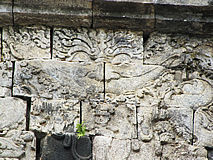 |
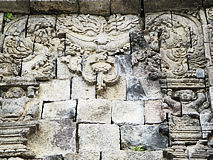 |
||
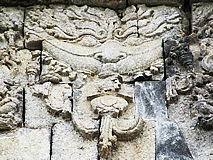 |
Kala is everywhere. Mendut isn't an exception to that rule. On the contrary She appears on all big carvings. Typical pattern includes the Gods in the middle with Kala on top. Current interpretations emphasize "his" function as "God of Time". Others stress "his" function as Guardian/Protector/ Demon. As I have said repeatedly (LINK Prambanan 2) these labels have been put on Her pretty recently. It was the effort to turn the original meaning into a decidedly patriarchal one.... | 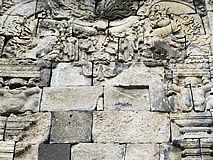 |
| F.i. isn't it strange that the "God of Time" who's function is to remind us of the transistoriliness of life - death - appears on top of the Gods, the latter being eternal Beings? To Gods time is irrelevant. So, to understand Kala we have to make a step back, to the times preceding Hinduism and Buddhism. There Kala - as the Great Black One - represents the Mother of the Gods. The One who's memory lived on in Buddhism as the "Womb of all Buddha's!" but wasn't understood. (LINK "Great Mother Buddhism", chapter "Womb of all Buddha's) | 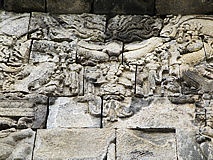 |
|
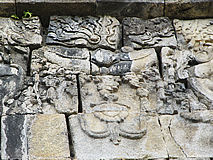 |
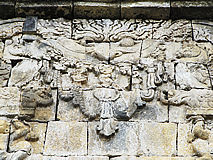 |
|
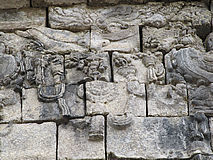 |
||
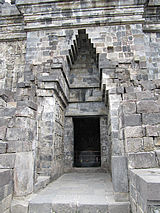 |
The interior Another strange phenomenon. Before entering the interior of the "Big Buddha" carvings reflect Hindu not Buddhist images. The three pots are offerings, true, but couldn't they also symbolize the Trimurti - Brahma, Visnu and Shiva - by the way all three "Sons of the Original Mother? The Celestial Tree is claimed by Buddhists to be the Tree of Buddha's Awakening. In reality, it is the pre-Buddhist Tree of Life, that made his Enlightenment possible! Below right the Goddess Hariti is portrayed. She is coming from the ancient Harappa or Indus culture culture which even preceded the Vedas. Later She was transformed into Buddha Maitreya! |
|
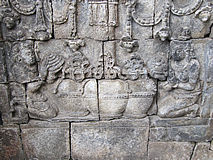 |
||
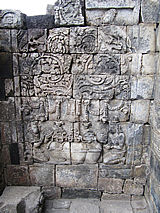 |
THE NEW GOD |
Goddess Hariti |
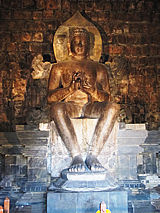 |
||
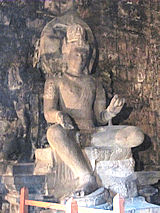 |
Right from the start I had a wierd feeling while entering the inner central room. While the atmosphere was very archaic, the Buddhas in the center somehow didn't fit into it. It was like they were put there at a later time. While looking more closely I saw two Makara's behind the Buddha's. Although knowing from literature that these were put there later on by Dutch archeologist Brandes, the question is where did they come from and why Brandes put them behind the Buddha's? |
|
| Makara's are almost always part of Kala imaginary. They represent the "Power of Emptiness". Have they thus been part of a Big Kala before? The latter later replaced by the Big Buddha? It wouldn't be a surprise at all. Because the Buddha came as a "New God" replacing the previous (Hindu) Deities. Like in Christianity Christ replaced the old "pagan" Vegetation Gods! | 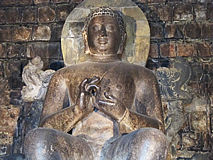 Buddha Sakyamuni with "his" two Makara's on his chair |
|
 |
Womb of the Tathagatha You may call it ironic, that if the previous hypothesis is true, the "New God" couldn't escape the archaic background previous to his coming. Isn't every central chamber of a Javanese Candi the symbol of a womb? A Cosmic Womb from which the Gods are born? In Menduts inner sacred chamber there are Kala's above every niche, apparently much older that the Big Buddha. Therefore Mark Long had a good intuition when he called Mendut the "Womb of the Tathagatha". I am not sure he is happy with the idea that the Buddha is thus the "Son of the Cosmic Mother!" |
|
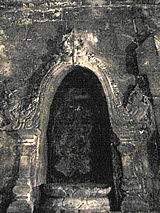 |
||
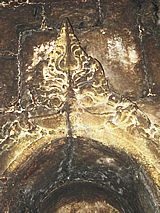 |
Everywhere niches with Kala Heads, typically very much neglected, because archeologists didn't think they were important..... |
|
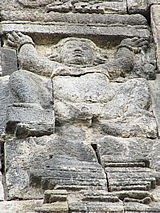 |
||
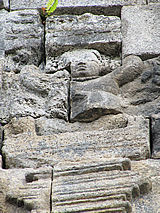 |
If my hypothesis is right and I am the first who very much would like to discuss it with my Javanese counterparts!, then Candi Mendut will get a totally different meaning.....Instead of being an exclusive Buddhist monument it could become a highlight of Javanese model of religious integration, starting with memories of the Original Mother, followed by Javanese Nature Religion and completed by Hinduism and Buddhism, the latter two of course very often "complementary" at many other Candi's, as well | 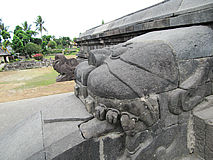 |
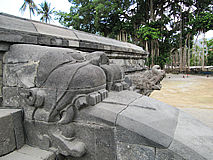 |
1997-2011
© Copyright Han Marie Stiekema. All rights reserved.
Everyone may use this website as a source of inspiration. However, since it
is freely given, no-one can claim, copy or derive any text, rights,
position or status from this website.
Last revising: 07/18/12

